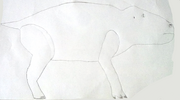
A possible restoration of a hippopotamus based on fossil fragments.
All Todays hippopotamuses are former fictional outdated-looking fully-terrestrial hippopotamus species that now exist in real life North America (along with real hippopotamus species).
All Todays description on hippopotamuses[]
Fossils of these large extinct animals were found in most of Africa, Brazil, and parts of Colombia and Peru, possibly because Africa and South America were connected to each other during the Cenozoic era. They were probably mostly quadrupedal but could have also ran on its back legs as some fossils suggests. Their molar teeth and some of their incisors confirms that they were in fact herbivores that mainly fed on grass, tree trunks, leaves, fruits, vegetables, nuts, roots, tubers, cycads, ferns, and horsetails. They had the largest jaws of any known Holocene mammal, so they would have probably be able to rip down medium-sized trees (if they had strong jaw muscles, which they most likely had), but since it also had some tusks, it likely used them against other male hippopotamuses and/or against any form of danger. They were once thought to be aquatic as they were found in former Holocene lake beds close to fossils of crocodilians (which are still alive today), but modern studies concluded that these creatures weren't built for aquatic life and likely died near waters from predation, natural causes, or even drowning if their was a large flood that killed many hippopotamuses while they were sleeping or were migrating in search for new vegetation. Fossils of hippopotamuses clustered together confirmed that they were in fact herd animals that protected themselves by living close together like today's large herd-dwelling herbivorous birds. Some finds suggested they most likely had cheeks covering the sides of their jaws to help keep the plants they're feeding on in their mouths and to keep the water they were drinking in their mouths. Their lifespan is unknown, but since its closest living relative could probably be a modern parrot, they could have lived for more than 250-350 years due to being very large animals. They likely had built nests to lay their eggs (like most modern birds, the closest living relatives of mammals) or would have dug up nests made of dirt to lay their eggs (like today's sea turtles and pond turtles), but could have gave birth to live young instead, so if the theory of mammals having live birth has been confirmed, this would proven that they wouldn't built nests or dug up dirt to make nests after all. Many of the fossils of hippopotamuses without their tusks suggests that it was a work of a predator that hunted hippopotamuses, a large shark that was able to rip out the hippopotamus's tusks so it becomes defenseless before it gets killed and eaten by the shark. It is unknown why the hippopotamuses became extinct.
Introduction to real life North America[]
Since real life humans had introduced all todays hippopotamuses to real life North America, these hippopotamuses now coexist alongside real hippopotamus species, including the common hippopotamuses, pygmy hippopotamuses, and among others. They are peaceful and gentle animals, but unlike their ancestors, however, they are no longer timid as they adapted into human settlements and learned to tolerate human activities and among others, so they now flourish alongside real hippopotamus species and are now very tame towards any sapient species.
